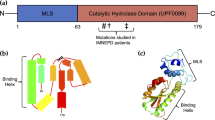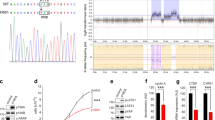Abstract
Trask/CDCP1 is a transmembrane glycoprotein widely expressed in epithelial tissues whose functions are just beginning to be understood, but include a role as an anti-adhesive effector of Src kinases. Early studies looking at RNA transcript levels seemed to suggest overexpression in some cancers, but immunostaining studies are now providing more accurate analyses of its expression. In an immuno-histochemical survey of human cancer specimens, we find that Trask expression is retained, reduced or sometimes lost in some tumors compared with their normal epithelial tissue counterparts. A survey of human cancer cell lines also show a similar wide variation in the expression of Trask, including some cell types with the loss of Trask expression, and additional cell types that have lost the physiological detachment-induced phosphorylation of Trask. Three experimental models were established to interrogate the role of Trask in tumor progression, including two gain-of-function models with tet-inducible expression of Trask in tumor cells lacking Trask expression, and one loss-of-function model to suppress Trask expression in tumor cells with abundant Trask expression. The induction of Trask expression and phosphorylation in MCF-7 cells and in 3T3v-src cells was associated with a reduction in tumor metastases while the shRNA-induced knockdown of Trask in L3.6pl cancer cells was associated with increased tumor metastases. The results from these three models are consistent with a tumor-suppressing role for Trask. These data identify Trask as one of several potential candidates for functionally relevant tumor suppressors on the 3p21.3 region of the genome frequently lost in human cancers.
This is a preview of subscription content, access via your institution
Access options
Subscribe to this journal
Receive 50 print issues and online access
$259.00 per year
only $5.18 per issue
Buy this article
- Purchase on Springer Link
- Instant access to full article PDF
Prices may be subject to local taxes which are calculated during checkout







Similar content being viewed by others
References
Abdel-Ghany M, Cheng HC, Elble RC, Pauli BU . (2002). Focal adhesion kinase activated by beta(4) integrin ligation to mCLCA1 mediates early metastatic growth. J Biol Chem 277: 34391–34400.
Awakura Y, Nakamura E, Takahashi T, Kotani H, Mikami Y, Kadowaki T et al. (2008). Microarray-based identification of CUB-domain containing protein 1 as a potential prognostic marker in conventional renal cell carcinoma. J Cancer Res Clin Oncol 134: 1363–1369.
Bhatt AS, Erdjument-Bromage H, Tempst P, Craik CS, Moasser MM . (2005). Adhesion signaling by a novel mitotic substrate of src kinases. Oncogene 24: 5333–5343.
Brakebusch C, Bouvard D, Stanchi F, Sakai T, Fassler R . (2002). Integrins in invasive growth. J Clin Invest 109: 999–1006.
Brown TA, Yang TM, Zaitsevskaia T, Xia Y, Dunn CA, Sigle RO et al. (2004). Adhesion or plasmin regulates tyrosine phosphorylation of a novel membrane glycoprotein p80/gp140/CUB domain-containing protein 1 in epithelia. J Biol Chem 279: 14772–14783.
Chen JS, Huang XH, Wang Q, Chen XL, Fu XH, Tan HX et al. (2010). FAK is involved in invasion and metastasis of hepatocellular carcinoma. Clin Exp Metastasis 27: 71–82.
Conze T, Lammers R, Kuci S, Scherl-Mostageer M, Schweifer N, Kanz L et al. (2003). CDCP1 is a novel marker for hematopoietic stem cells. Ann N Y Acad Sci 996: 222–226.
Felding-Habermann B . (2003). Integrin adhesion receptors in tumor metastasis. Clin Exp Metastasis 20: 203–213.
Hanada M, Tanaka K, Matsumoto Y, Nakatani F, Sakimura R, Matsunobu T et al. (2005). Focal adhesion kinase is activated in invading fibrosarcoma cells and regulates metastasis. Clin Exp Metastasis 22: 485–494.
Hirohashi S, Kanai Y . (2003). Cell adhesion system and human cancer morphogenesis. Cancer Sci 94: 575–581.
Hood JD, Cheresh DA . (2002). Role of integrins in cell invasion and migration. Nat Rev Cancer 2: 91–100.
Hooper JD, Zijlstra A, Aimes RT, Liang H, Claassen GF, Tarin D et al. (2003). Subtractive immunization using highly metastatic human tumor cells identifies SIMA135/CDCP1, a 135 kDa cell surface phosphorylated glycoprotein antigen. Oncogene 22: 1783–1794.
Ikeda JI, Morii E, Kimura H, Tomita Y, Takakuwa T, Hasegawa JI et al. (2006). Epigenetic regulation of the expression of the novel stem cell marker CDCP1 in cancer cells. J Pathol 210: 75–84.
Ikeda J, Oda T, Inoue M, Uekita T, Sakai R, Okumura M et al. (2009). Expression of CUB domain containing protein (CDCP1) is correlated with prognosis and survival of patients with adenocarcinoma of lung. Cancer Sci 100: 429–433.
Ji L, Minna JD, Roth JA . (2005). 3p21.3 tumor suppressor cluster: prospects for translational applications. Future Oncol 1: 79–92.
Kessenbrock K, Plaks V, Werb Z . (2010). Matrix metalloproteinases: regulators of the tumor microenvironment. Cell 141: 52–67.
Lahlou H, Sanguin-Gendreau V, Zuo D, Cardiff RD, McLean GW, Frame MC et al. (2007). Mammary epithelial-specific disruption of the focal adhesion kinase blocks mammary tumor progression. Proc Natl Acad Sci USA 104: 20302–20307.
Mamat S, Ikeda J, Enomoto T, Ueda Y, Rahadiani N, Tian T et al. (2010). Prognostic significance of CUB domain containing protein expression in endometrioid adenocarcinoma. Oncol Rep 23: 1221–1227.
Miyazawa Y, Uekita T, Hiraoka N, Fujii S, Kosuge T, Kanai Y et al. (2010). CUB domain-containing protein 1, a prognostic factor for human pancreatic cancers, promotes cell migration and extracellular matrix degradation. Cancer Res 70: 5136–5146.
Perry SE, Robinson P, Melcher A, Quirke P, Buhring HJ, Cook GP et al. (2007). Expression of the CUB domain containing protein 1 (CDCP1) gene in colorectal tumour cells. FEBS Lett 581: 1137–1142.
Pietras K, Ostman A . (2010). Hallmarks of cancer: interactions with the tumor stroma. Exp Cell Res 316: 1324–1331.
Provenzano PP, Inman DR, Eliceiri KW, Beggs HE, Keely PJ . (2008). Mammary epithelial-specific disruption of focal adhesion kinase retards tumor formation and metastasis in a transgenic mouse model of human breast cancer. Am J Pathol 173: 1551–1565.
Ramsay AG, Marshall JF, Hart IR . (2007). Integrin trafficking and its role in cancer metastasis. Cancer Metastasis Rev 26: 567–578.
Rathinam R, Alahari SK . (2010). Important role of integrins in the cancer biology. Cancer Metastasis Rev 29: 223–237.
Scherl-Mostageer M, Sommergruber W, Abseher R, Hauptmann R, Ambros P, Schweifer N . (2001). Identification of a novel gene, CDCP1, overexpressed in human colorectal cancer. Oncogene 20: 4402–4408.
Shibue T, Weinberg RA . (2009). Integrin beta1-focal adhesion kinase signaling directs the proliferation of metastatic cancer cells disseminated in the lungs. Proc Natl Acad Sci USA 106: 10290–10295.
Siva AC, Wild MA, Kirkland RE, Nolan MJ, Lin B, Maruyama T et al. (2008). Targeting CUB domain-containing protein 1 with a monoclonal antibody inhibits metastasis in a prostate cancer model. Cancer Res 68: 3759–3766.
Spassov DS, Ahuja D, Wong CH, Moasser MM . (2011a). The structural features of Trask that mediate its anti-adhesive functions. PLoS One 6: e19154.
Spassov DS, Baehner FL, Wong CH, McDonough S, Moasser MM . (2009). The transmembrane src substrate Trask is an epithelial protein that signals during anchorage deprivation. Am J Pathol 174: 1756–1765.
Spassov DS, Wong CH, Sergina N, Ahuja D, Fried M, Sheppard D et al. (2011b). Phosphorylation of Trask by Src kinases inhibits integrin clustering and functions in exclusion with focal adhesion signaling. Mol Cell Biol 31: 766–782.
Spiegelberg BD, Hamm HE . (2007). Roles of G-protein-coupled receptor signaling in cancer biology and gene transcription. Curr Opin Genet Dev 17: 40–44.
Srinivasan DM, Kapoor M, Kojima F, Crofford LJ . (2005). Growth factor receptors: implications in tumor biology. Curr Opin Investig Drugs 6: 1246–1249.
Sun H, Pisle S, Gardner ER, Figg WD . (2010). Bioluminescent imaging study: FAK inhibitor, PF-562,271, preclinical study in PC3M-luc-C6 local implant and metastasis xenograft models. Cancer Biol Ther 10: 38–43.
Tang J, Wu YM, Zhao P, Yang XM, Jiang JL, Chen ZN . (2008). Overexpression of HAb18G/CD147 promotes invasion and metastasis via alpha3beta1 integrin mediated FAK-paxillin and FAK-PI3K-Ca2+ pathways. Cell Mol Life Sci 65: 2933–2942.
Tlsty TD, Coussens LM . (2006). Tumor stroma and regulation of cancer development. Annu Rev Pathol 1: 119–150.
Trimmer C, Whitaker-Menezes D, Bonuccelli G, Milliman JN, Daumer KM, Aplin AE et al. (2010). CAV1 inhibits metastatic potential in melanomas through suppression of the integrin/Src/FAK signaling pathway. Cancer Res 70: 7489–7499.
Uekita T, Tanaka M, Takigahira M, Miyazawa Y, Nakanishi Y, Kanai Y et al. (2008). CUB-domain-containing protein 1 regulates peritoneal dissemination of gastric scirrhous carcinoma. Am J Pathol 172: 1729–1739.
Van Nimwegen MJ, Verkoeijen S, van Buren L, Burg D, van de Water B . (2005). Requirement for focal adhesion kinase in the early phase of mammary adenocarcinoma lung metastasis formation. Cancer Res 65: 4698–4706.
Walsh C, Tanjoni I, Uryu S, Tomar A, Nam JO, Luo H et al. (2010). Oral delivery of PND-1186 FAK inhibitor decreases tumor growth and spontaneous breast to lung metastasis in pre-clinical models. Cancer Biol Ther 9: 778–790.
Wistuba II, Behrens C, Virmani AK, Mele G, Milchgrub S, Girard L et al. (2000). High resolution chromosome 3p allelotyping of human lung cancer and preneoplastic/preinvasive bronchial epithelium reveals multiple, discontinuous sites of 3p allele loss and three regions of frequent breakpoints. Cancer Res 60: 1949–1960.
Wong CH, Baehner FL, Spassov DS, Ahuja D, Wang D, Hann B et al. (2009). Phosphorylation of the SRC epithelial substrate Trask is tightly regulated in normal epithelia but widespread in many human epithelial cancers. Clin Cancer Res 15: 2311–2322.
Acknowledgements
This work was funded by the National Institutes of Health CA113952 (MMM). DS is funded by a Susan G Komen for the Cure Postdoctoral Fellowship. CHW is funded by a California Breast Cancer Research Program Postdoctoral Fellowship. We wish to thank Michael McManus and the UCSF Sandler Lentiviral RNAi core facility. We acknowledge the use of core facilities of the UCSF Helen Diller Family Comprehensive Cancer Center, including the Preclinical Therapeutics Core, the immunohistochemistry core and the mouse pathology core.
Author information
Authors and Affiliations
Corresponding author
Ethics declarations
Competing interests
The authors declare no conflict to interest.
Additional information
Supplementary Information accompanies the paper on the Oncogene website
Supplementary information
Rights and permissions
About this article
Cite this article
Spassov, D., Wong, C., Harris, G. et al. A tumor-suppressing function in the epithelial adhesion protein Trask. Oncogene 31, 419–431 (2012). https://doi.org/10.1038/onc.2011.246
Received:
Revised:
Accepted:
Published:
Issue Date:
DOI: https://doi.org/10.1038/onc.2011.246
Keywords
This article is cited by
-
Regulation of inside-out β1-integrin activation by CDCP1
Oncogene (2018)
-
Identification of anti-tumour biologics using primary tumour models, 3-D phenotypic screening and image-based multi-parametric profiling
Molecular Cancer (2015)
-
CUB Domain Containing Protein 1 (CDCP1) modulates adhesion and motility in colon cancer cells
BMC Cancer (2014)



